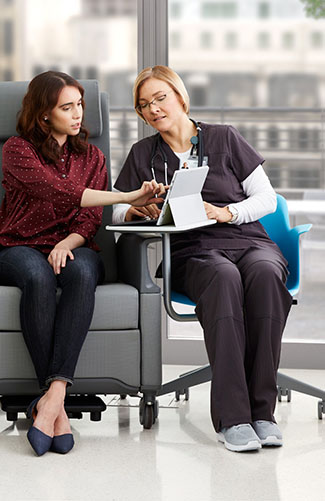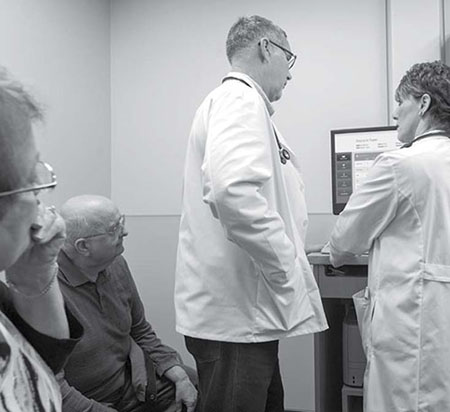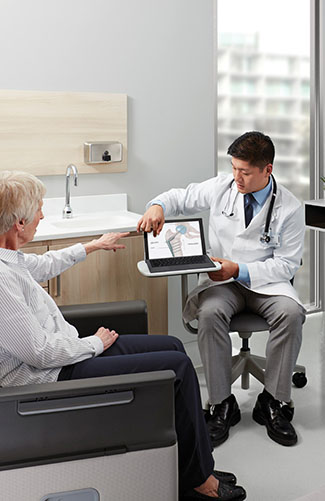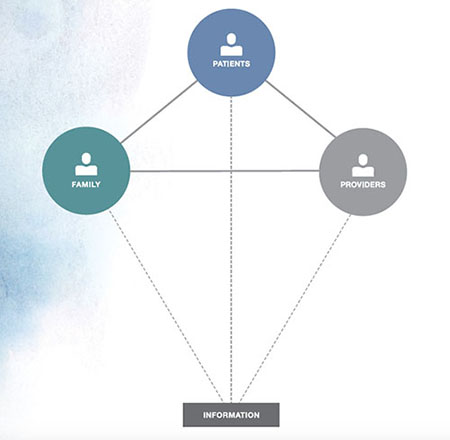Steelcase Health Research: Exam Experiences Reimagined

The business of healthcare is changing. Yes, many parts of the healthcare industry are becoming more businesslike – but in a good way, to the great benefit of patients. Steelcase Health recently released new research on how design can help improve the exam room experience for patients and their family members, as well as for care providers. Its white paper on the subject, “Transforming the Exam Room: Designing for Mutual Participation,” explores how to evolve the exam room into one that builds more patient trust and confidence.
To start, Steelcase Health took a deep dive into the history behind how people have received healthcare over the years. They found that everything from the types of care patients need to expectations, technology, and even the way clinicians and patients interact, has evolved dramatically.
“History tells us that the doctor-patient relationship derived from the priest-supplicant relationship, placing doctors as healers and keepers of mystical medical knowledge,” states the Steelcase white paper. “Patients were helpless to contribute to their own cures and only the doctor knew the ways of medicine and had the authority to conduct the rituals of healing. In this dynamic, the locus of control was with the doctor and the patient was seen as hardly more than a disease or condition, with little say in the situation.”
This is called the Activity-Passivity model. In certain situations, such as when performing an operation, this model is of course still necessary.
 Another major method of care interaction is the Guidance-Cooperation model; it shifts perspective from “patient as disease” to “patient as person” and functions much like “the interaction between a parent and child, where the doctor’s role is to tell the patient what to do and the patient’s role is to cooperate. This interaction can be seen in patient rooms, imaging suites and treatment areas where clinicians may be delivering medications or changing dressings, positioning a patient for a scan or administering chemotherapy.”
Another major method of care interaction is the Guidance-Cooperation model; it shifts perspective from “patient as disease” to “patient as person” and functions much like “the interaction between a parent and child, where the doctor’s role is to tell the patient what to do and the patient’s role is to cooperate. This interaction can be seen in patient rooms, imaging suites and treatment areas where clinicians may be delivering medications or changing dressings, positioning a patient for a scan or administering chemotherapy.”
Fast-forward to today – a healthcare arena where the focus centers on “lifestyle and behavioral changes needed to control and prevent chronic conditions like hypertension, diabetes and obesity.”
Steelcase presented its new research focusing on the Mutual Participation model, and presented a new set of design principles, exam room concepts and new product ideas to help designers create spaces that meet today’s needs.

Drivers for Change
– Steelcase identified the following factors driving the need for change in healthcare design to accommodate new interactions:
>Shift in discussions and decisions from taking curative steps – “take two tablets and call me in the morning” – to “lifestyle and behavior changes.”
These interactions aren’t “simple one-and-done conversations; rather, they require empathy, understanding and education. Outdated space configurations, centered around the exam table, make eye-to-eye conversations difficult. Access to information require to reach mutual decisions is hard to share, whether it’s doctors sharing test results or patients and their families bringing in their own research.
>Physicians feel “greater pressure to deliver more efficient care – to spend less time with patients and, at the same time, provide an exceptional experience.”
 “Clinicians are keenly and, some might say, painfully aware that patient satisfaction scores directly impact compensation models and influence patients’ choice of healthcare providers in an increasingly competitive environment.
“Clinicians are keenly and, some might say, painfully aware that patient satisfaction scores directly impact compensation models and influence patients’ choice of healthcare providers in an increasingly competitive environment.
>New technology, particularly the recent wide adoption of electronic medical records, presents benefits and barriers.
For example, “Physicians struggle to adopt comfortable conversational postures and maintain eye contact while they chart from their stool, leaning up against a wall for awkward back support.”
All of these things are “further complicated by the fact that many doctors struggle daily with symptoms of mental and emotional burnout, feeling they’re on autopilot instead of hands-on healers.”
Designing for Mutual Participation
Today’s focus on preventive care and chronic illnesses requires a different type of interaction – one built on doctor-patient-family member collaboration.
The Mutual Participation model is “a doctor-patient partnership, where the doctor helps the patient to help themselves…Mutual Participation is best suited for the care of chronic conditions because the treatment plan is carried out by the patient at home, away from the direct actions and control of the doctor. However, information sharing and decision making, central to the care of the patient, happens in the exam room.
 “Where Guidance-Cooperation may have been sufficient in the past, Steelcase Health researchers believe that cultural changes and modern healthcare context now make the Mutual Participation model increasingly important and valuable.”
“Where Guidance-Cooperation may have been sufficient in the past, Steelcase Health researchers believe that cultural changes and modern healthcare context now make the Mutual Participation model increasingly important and valuable.”
“Steelcase Health researchers define Mutual Participation in three dimensions: Interpersonal Sensitivity, Egalitarian Presence and Shared Decision Making.
Interpersonal Sensitivity addresses the fundamental orientation the doctor and patient have toward one another. The doctor approaches the patient holistically, not just as a disease or symptom…But Interpersonal Sensitivity is intended to work both ways – the patient also needs to recognize that doctors are people too, and bring their own values, experiences and needs to the interaction.”
Steelcase’s design guidelines for achieving Interpersonal Sensitivity include:
>Exam rooms should be designed to support eye-to-eye conversation. Doctors, patients and family members need unobstructed sightlines to each other. At the same time, care providers need to be able to perform necessary tasks like charting without disrupting the connection with the patient.
>Doctors need the ability to smoothly move between exam and consulting activities, and perform technical procedures as well as express empathy, like patting a patient’s shoulder or holding a patient’s hand.
 >Patients need to be able to include their family members as critical supporters of their care, and help the doctor understand the patient’s social situation.
>Patients need to be able to include their family members as critical supporters of their care, and help the doctor understand the patient’s social situation.
Egalitarian Presence addresses the dynamic between doctors and patients, who “have approximately equal agency, are interdependent and engage in activities that are meaningful to both. The patient is encouraged to educate the doctor on his or her goals, preferences and values and engage in decisions about care.”
Steelcase’s design guidelines for achieving Egalitarian Presence include:
>Furniture, technology and physical placement in the room designed in a way that encourages participation from all players. For conversations, everyone is at the same seated height, sharing access to information on computer screens. Family members also need to be given a “seat at the table” so they can offer insight, observations and support to the exchange. When everyone is present in a way that allows for shared control, collaboration can occur more naturally.
Finally, Shared Decision Making is critical; in its research review, Steelcase found a growing trend for patients to want to share in decision making with doctors. “K. E. Flynn and colleagues reported in a 2006 study of over 5000 older adults that 96% preferred to engage in exchanging information with their doctors…For true shared decision making to occur, both share information, build consensus about preferred treatment and reach agreement on a treatment plan.”
Steelcase’s design guidelines for achieving Shared Decision Making include:
>Emphasis on ease of information exchange. To promote transparency, exam rooms need to facilitate clinicians sharing the screen to review records, teach and engage patients in discussion. Traditional exam rooms place the monitor for the sole use of the clinician, creating a barrier to information sharing, and lack work surfaces that enable printed information to be reviewed.
A New Design Paradigm
To address all of these design goals, Steelcase presented a new design paradigm called “The Diamond.”
 The Diamond uses an orientation of participants that allows optimal eye contact and shoulder-to-shoulder interaction, and also includes the presence of information.
The Diamond uses an orientation of participants that allows optimal eye contact and shoulder-to-shoulder interaction, and also includes the presence of information.
“In some exam rooms, the traditional exam table can be easily replaced with a lower exam chair, so now patient, physician and family members are all at the same level,” says Caroline Kelly, Steelcase principal research, in the white paper. “Easy access to technology and tools allows for a fluid transition between activities, and a monitor displays important information for shared decision making.
This new paradigm supports the behaviors that are essential for effective healthcare and maintaining personal relationships between patients and staff that impact satisfaction scores. It includes family as equally important in the patient’s health, and supports clinicians’ physical needs as well. Instead of being intrusive, technology is sensitively integrated into the experience to support conversation.”
The evolving healthcare landscape is placing more pressure on care providers. But, thinking about how to design healthcare spaces better can help alleviate that pressure in many ways.
“Exam rooms today must be hardworking, high-functioning spaces that encourage the activities, interactions and technologies that create and sustain connected, satisfying and effective health experiences…The sharing of space and information is the new design principle for exam rooms.”



